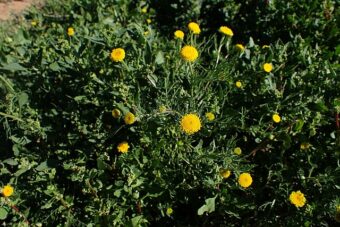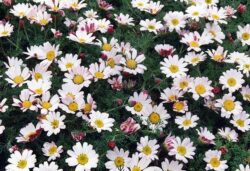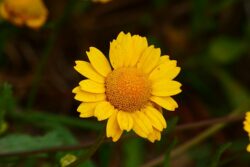In this article, we will discuss how to grow Anacyclus in containers. They are members of the Aster family where over 32000 species are noted to exist.
It may be surprising but this hardy alpine perennial is not very often seen in the garden but this should change as it is a delightful plant. It has the common name of Mount Atlas Daisy, Spanish Chamomile or White Button. They are small alpine plants that only grow up to 5cm high and produce white or yellow daisy-like flowers.

As the plants are small and have a rosette of prostrating stems that bears grey-green ferny foliage. On top of these leaves rich red buds open to reveal up to 5cm tall large white or yellow daisy-like blooms. Because of their compact nature in height and its spreading nature, will make them ideal to grow cascading over the edge of containers.
They may not be seen often in the garden but they are beautiful flowers that should be grown more often.
GROWING ANACYCLUS IN CONTAINERS
You can grow annual species of Anacyclus from seeds, whilst perennial species tend to be grown from either shop-bought plants or from seeds.
GROWING FROM SEED
It is best to sow seeds freshly as it will increase the chances of success. Fill a seed tray with a good quality seed compost and water it well so the compost is moist. Sprinkle the seeds over and cover them with a fine layer of vermiculite to approximately their own depth. With this seed, it is best to place them in spring in a cool greenhouse, waiting for natural germination to take place.

It may take a period of coolness to break its dormancy mechanism. You may get better results if you pre-chill the seeds for 3 weeks before sowing. Pre-chilling was traditionally done by standing the pots outside in a cold frame during winter but it is quicker by using a refrigerator (very useful if you bought your seeds outside the winter months).
To pre-chill, first, sow the seeds in moistened seed compost and seal the container and seeds inside a polythene bag. You will then need to leave the sealed container in a cool room between 13 to 15 degrees Celsius for 3 days. After this period, place it in a refrigerator for 3 weeks. You must ensure that there is sufficient air inside the polythene bag and that the compost must never become too dry or too wet. After this period the seeds can be sown as described above. You will need to examine the seeds every week and remove any that have germinated.
Once the seedlings are large enough, you can prick them out and transplant them individually to 7.5cm pots full of multipurpose compost. Allow them to grow on and when large enough, you can plant them out in containers after hardening them off for two weeks.
ANACYCLUS IN CONTAINERS
At this stage, you can treat home-reared Anacyclus and garden-ready plants can be treated in exactly the same way. First, select an appropriate sized container that has plenty of drainage holes. To the bottom of this add a 1cm layer of grit to help drainage. Anacyclus love the compost to be free-draining and so you will need to mix 70% by volume of multipurpose compost with 30% horticultural grit. Fill the container with this growing media up to 5cm below the rim.
Dig a hole in the container slightly larger than the root ball it came in the original container. Drop the plant in so that the top of the root ball is at the same level as the top surface of the compost. Backfill with the growing media ensuring that no gaps remain, using more compost if it is needed. Firm the plant in and water well. You will need to cover the surface of the compost in the container with fine stones to improve surface drainage.
Place the container where it can get as much full sun as possible in a sheltered location.
It will need to be watered in dry conditions, especially when the top 25% of the container feels dry to the touch. It is not particular a hungry plant used to growing in poor, rocky conditions but if your plant is struggling you can give it a quick pick-me-up by dressing it with fish, blood and bone in spring.
In winter, you may need to protect the crown from excess moisture by moving it into a rain shadow. Once the flower blooms are spent, you can cut them out.
PESTS AND DISEASES
Generally, these plants do not suffer from any diseases but they can be attacked by aphids. If this happens blast them with jets of water to remove them or if it is very bad, you can use a systemic insecticide.
VARIETIES TO GROW

The most commonly grown species in the UK is Anacyclus depressus (A. pyrethrum var. depressus). This is a mat-forming, evergreen perennial with grey-green, feathery leaves and white daisy-like flowers. ‘Golden Thane’ produces yellow flowers but it is hard to find.
Anacyclus officinarum is an annual that grows up to 30cm high with white flowers.
Anacyclus radiatus is a taller annual that grows up to 60cm high and also has white flowers.
CONCLUSIONS
In this article, we have discussed how to grow the not so often seen alpine perennial of Anacyclus in containers. As you can see it is easy to grow and easy to look after as long as you give its preferred growing media that must be free-draining.
They are not attacked by pests and diseases and produce wonderful daisy-like flowers. What more is there to like?
If you have any questions or comments that you wish to make on growing Anacyclus in containers, please do so in the comment box below.
Happy Anacyclus growing.
